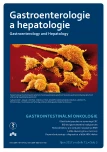Diagnosis and therapy of hepatitis B virus infection – Czech national guidelines
Authors:
P. Husa 1; J. Šperl 2; P. Urbánek 3; S. Fraňková 2; S. Plíšek 4; P. Kümpel 5; L. Rožnovský 6
Authors‘ workplace:
Klinika infekčních chorob LF MU a FN Brno
1; Klinika hepatogastroenterologie, Transplantcentrum, IKEM, Praha
2; Interní klinika 1. LF UK a ÚVN – VFN Praha
3; Klinika infekčních nemocí LF UK a FN Hradec Králové
4; Infekční oddělení, Slezská nemocnice v Opavě, p. o.
5; Klinika infekčního lékařství LF OU a FN Ostrava
6
Published in:
Gastroent Hepatol 2017; 71(5): 419-437
Category:
Hepatology: Best Practises
doi:
https://doi.org/10.14735/amgh2017419
Overview
The new recommendations reflect the increase in knowledge that has been reported since the release of previous Czech guidelines in September, 2014. The basis for these guidelines are the European Association for the Study of the Liver guidelines of April, 2017. According to recent estimates, there are 240 million people with chronic hepatitis B (HBV) infection worldwide. The Czech Republic is among the countries with a low prevalence of HBV infection. According to the latest seroprevalent study, 0.56% of Czech citizens were chronically infected with HBV in 2001. A similar study in 2013 performed in only two regions of the Czech Republic found a prevalence rate of only 0.064%. HBV infection can lead to serious life-threatening liver damage, such as fulminant hepatitis, liver cirrhosis, and hepatocellular carcinoma (HCC). The main goal of treatment is to prolong and improve quality of life for the patient by preventing progression from chronic hepatitis to cirrhosis, cirrhosis decompensation, and development of HCC. This goal can be achieved if HBV replication is suppressed in a sustained manner. Additional goals are the prevention of vertical transmission from mother to newborn, inhibition of HBV reactivation, and the development of a therapy for HBV-related extrahepatic manifestations. Generally, two different strategies for chronic hepatitis B therapy are available – treatment with nucleoside or nucleotide inhibitors (NA) and treatment with pegylated interferon alfa. Currently, the majority of Czech and European patients are treated with NAs. The NAs that have been approved by the European Union for HBV treatment include lamivudine, adefovir dipivoxil, entecavir (ETV), telbivudin (TBV), tenofovir disoproxil fumarate (TDF), and tenofovir alafenamide (TAF). TAF and TBV are not yet commercially available in Czech Republic. The main advantage of treatment with potent NAs with high barriers to resistance (ETV, TDF, and TAF) is the predictably high long-term antiviral efficacy, which leads to undetectable HBV DNA levels in the vast majority of compliant patients as well a favorable safety profile. These drugs can be used in any HBV-infected patient and represent the only treatment option for patients with decompensated liver cirrhosis, liver transplants, extrahepatic HBV-related manifestations, severe acute hepatitis B, or chronic HBV reactivation.
Key words:
hepatitis B, chronic – entecavir – tenofovir disoproxil fumarate – tenofovir alafenamide – pegylated interferon alfa
The authors declare they have no potential conflicts of interest concerning drugs, products, or services used in the study.
The Editorial Board declares that the manuscript met the ICMJE „uniform requirements“ for biomedical papers.
Sources
1. Husa P, Šperl J, Urbánek P et al. Doporučený postup diagnostiky a léčby chronické hepatitidy B. Gastroent Hepatol 2014; 68 (6): 514–526. doi: 10.14735/amgh2014 514.
2. Husa P, Šperl J, Urbánek P et al. Doporučený postup diagnostiky a léčby chronické hepatitidy B. Klin Mikrobiol Infekc Lek 2014; 20 (4): 121–132.
3. European Association for the Study of the Liver. EASL 2017 Clinical Practice Guidelines on the management of hepatitis B virus infection. J Hepatol 2017; 67 (2): 370–398. doi: 10.1016/j.hep.2017.03. 021.
4. Nemecek V, Castkova J, Fritz P et al. The 2001 serological survey in the Czech Republic – viral hepatitis. Cent Eur J Public Health 2003; 11 (Suppl): S54–S61.
5. Zdravotní ústav se sídlem v Ostravě, Zdravotní ústav se sídlem v Ústí nad Labem. Víceúčelový sérologický přehled (spalničky, příušnice, pertuse, virová hepatitida B) SP 2013, ČR. Závěrečná zpráva. CEM SZÚ 2014; 23 (Příloha 1): 1–152.
6. Státní zdravotní ústav. Infekce v ČR – EPIDAT. [online]. Dostupné z: www.szu.cz/publikace/data/infekce-v-cr.
Labels
Paediatric gastroenterology Gastroenterology and hepatology SurgeryArticle was published in
Gastroenterology and Hepatology

2017 Issue 5
Most read in this issue
- Meteospasmyl – a fixed combination of alverine citrate and simethicone in the treatment of digestive tract functional disorders
-
Endosonograficky navigovaná drenáž pankreatických kolekcí
– vlastní zkušenosti - Modern treatment of oesophageal cancer, gastroesophageal junction and stomach – 2017 update
- Risk factors for local residual neoplasia after endoscopic mucosal resection
